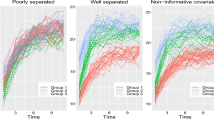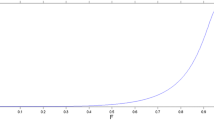Abstract
Nonlinear mixed effects models have received a great deal of attention in the statistical literature in recent years because of their flexibility in handling longitudinal studies, including human immunodeficiency virus viral dynamics, pharmacokinetic analyses, and studies of growth and decay. A standard assumption in nonlinear mixed effects models for continuous responses is that the random effects and the within-subject errors are normally distributed, making the model sensitive to outliers. We present a novel class of asymmetric nonlinear mixed effects models that provides efficient parameters estimation in the analysis of longitudinal data. We assume that, marginally, the random effects follow a multivariate scale mixtures of skew-normal distribution and that the random errors follow a symmetric scale mixtures of normal distribution, providing an appealing robust alternative to the usual normal distribution. We propose an approximate method for maximum likelihood estimation based on an EM-type algorithm that produces approximate maximum likelihood estimates and significantly reduces the numerical difficulties associated with the exact maximum likelihood estimation. Techniques for prediction of future responses under this class of distributions are also briefly discussed. The methodology is illustrated through an application to Theophylline kinetics data and through some simulating studies.








Similar content being viewed by others
References
Arellano-Valle RB, Bolfarine H, Lachos VH (2005) Skew-normal linear mixed models. J Data Sci 3:415–438
Azzalini A, Capitanio A (1999) Statistical applications of the multivariate skew-normal distribution. J R Stat Soc 61:579–602
Boeckmann AJ, Sheiner LB, Beal SL (1994) Nonmem users guide-part V: introductory guide. NONMEM Project Group. University of California at San Francisco
Branco MD, Dey DK (2001) A general class of multivariate skew-elliptical distributions. J Multivar Anal 79:99–113
De la Cruz R (2014) Bayesian analysis for nonlinear mixed-effects models under heavy-tailed distributions. Pharm Stat 13(1):81–93
Dempster A, Laird N, Rubin D (1977) Maximum likelihood from incomplete data via the EM algorithm. J R Stat Soc Ser B 39:1–38
Galarza CE, Castro LM, Louzada F, Lachos VH (2020) Quantile regression for nonlinear mixed effects models: a likelihood based perspective. Stat Pap 61(3):1281–1307
Hartford A, Davidian M (2000) Consequences of misspecifying assumptions in nonlinear mixed effects models. Comput Stat Data Anal 34:139–164
Healy MJR (1968) Multivariate normal plotting. J R Stat Soc Ser C (Appl Stat) 17(2):157–161
Hui FKC, Müller S, Welsh AH (2020) Random effects misspecification can have severe consequences for random effects inference in linear mixed models. Int Stat Rev. https://doi.org/10.1111/insr.12378
Lachos VH, Bandyopadhyay D, Dey DK (2011) Linear and nonlinear mixed-effects models for censored HIV viral loads using normal/independent distributions. Biometrics 67(4):1594–1604
Lachos VH, Castro LM, Dey DK (2013) Bayesian inference in nonlinear mixed-effects models using normal independent distributions. Comput Stat Data Anal 64:237–252
Lachos VH, Ghosh P, Arellano-Valle RB (2010) Likelihood based inference for skew-normal independent linear mixed models. Stat Sin 20:303–322
Lin TI, Wang WL (2017) Multivariate-nonlinear mixed models with application to censored multi-outcome aids studies. Biostatistics 18(4):666–681
Lindstrom MJ, Bates DM (1990) Nonlinear mixed-effects models for repeated-measures data. Biometrics 46:673–687
Litière S, Alonso A, Molenberghs G (2007) The impact of a misspecified random-effects distribution on the estimation and the performance of inferential procedures in generalized linear mixed models. Stat Med 27:3125–31447
Liu C, Rubin DB (1994) The ECME algorithm: a simple extension of EM and ECM with faster monotone convergence. Biometrika 80:267–278
Matos LA, Prates MO, Chen MH, Lachos VH (2013) Likelihood-based inference for mixed-effects models with censored response using the multivariate-t distribution. Stat Sin 23:1323–1345
Meng X, Rubin DB (1993) Maximum likelihood estimation via the ECM algorithm: a general framework. Biometrika 81:633–648
Meza C, Osorio F, De la Cruz R (2012) Estimation in nonlinear mixed-effects models using heavy-tailed distributions. Stat Comput 22(1):121–139
Pereira MAA, Russo CM (2019) Nonlinear mixed-effects models with scale mixture of skew-normal distributions. J Appl Stat 46(9):1602–1620
Pinheiro JC, Bates DM (1995) Approximations to the log-likelihood function in the nonlinear mixed effects model. J Comput Graph Stat 4:12–35
Pinheiro JC, Bates DM (2000) Mixed-effects models in S and S-PLUS. Springer, New York
Pinheiro JC, Liu CH, Wu YN (2001) Efficient algorithms for robust estimation in linear mixed-effects models using a multivariate t-distribution. J Comput Graph Stat 10:249–276
R Core Team (2020) R: a language and environment for statistical computing. R Foundation for Statistical Computing, Vienna. https://www.R-project.org/. Accessed 26 July 2020
Rao CR, Ali H (1998) An overall test for multivariate normality. Student 2:317–324
Rosa GJM, Padovani CR, Gianola D (2003) Robust linear mixed models with normal/independent distributions and Bayesian MCMC implementation. Biom J 45:573–590
Russo CM, Paula GA, Aoki R (2009) Influence diagnostics in nonlinear mixed-effects elliptical models. Comput Stat Data Anal 53:4143–4156
Schumacher FL, Lachos VH, Dey DK (2017) Censored regression models with autoregressive errors: a likelihood-based perspective. Can J Stat 45(4):375–392
Schumacher FL, Matos LA, Lachos VH (2020) skewlmm: scale mixtures of skew-normal linear mixed models. https://CRAN.R-project.org/package=skewlmm. R package version 0.2.0
Schumacher FL, Matos LA, Lachos VH (2021) Scale mixture of skew-normal linear mixed models with within-subject serial dependence. Stat Med (in press). Ar**v preprint ar**v:2002.01040
Verbeke G, Lesaffre E (1996) A linear mixed-effects model with heterogeneity in the random-effects population. J Am Stat Assoc 91:217–221
Wu L (2004) Exact and approximate inferences for nonlinear mixed-effects models with missing covariates. J Am Stat Assoc 99:700–709
Wu L (2010) Mixed effects models for complex data. Chapman and Hall/CRC, Boca Raton
Zhang D, Davidian M (2001) Linear mixed models with flexible distributions of random effects for longitudinal data. Biometrics 57:795–802
Acknowledgements
We are grateful to the anonymous referee, the associate editor and the editor for very useful comments and suggestions, which greatly improved this paper. Fernanda L. Schumacher acknowledges the partial support of Coordenação de Aperfeiçoamento de Pessoal de Nível Superior—Brasil (CAPES)—Finance Code 001, and by Conselho Nacional de Desenvolvimento Científico e Tecnológico—Brasil (CNPq).
Author information
Authors and Affiliations
Corresponding author
Ethics declarations
Conflict of interest
The authors declare that they have no conflict of interest.
Additional information
Publisher's Note
Springer Nature remains neutral with regard to jurisdictional claims in published maps and institutional affiliations.
This article is part of the topical collection “Celebrating the Centenary of Professor C. R. Rao” guest edited by, Ravi Khattree, Sreenivasa Rao Jammalamadaka, and M. B. Rao.
Rights and permissions
About this article
Cite this article
Schumacher, F.L., Dey, D.K. & Lachos, V.H. Approximate Inferences for Nonlinear Mixed Effects Models with Scale Mixtures of Skew-Normal Distributions. J Stat Theory Pract 15, 60 (2021). https://doi.org/10.1007/s42519-021-00172-5
Accepted:
Published:
DOI: https://doi.org/10.1007/s42519-021-00172-5




